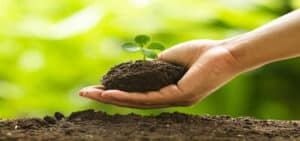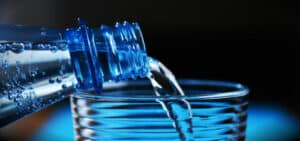All plants have five basic requirements, which are as follows: sunlight, water, nitrogen, phosphorous, and potassium. Since many years ago, farmers have been looking for a way to restore nitrogen, potassium, and phosphorous in the soil so that crop yields don’t decline over time.
Scientists have understood many things in these years; for example, they figured out there is some bacteria in the root of legumes such as peas and beans that can fill up nitrogen in the soil again.
“Later, two German chemists, Fritz Haber and Carl Bosch, devised a way to transform nitrogen in the air into fertilizer, using what became known as the Haber-Bosch process.”
They successfully took nitrogen from the air and bound it to hydrogen to form ammonia, winning the Nobel Prize for this huge discovery.
What types of fertilizers do we have?
In fact, we have two kinds of fertilizer for plants: organic and inorganic.
1. Organic fertilizers
Organic fertilizers derive from plants and animals. They can add carbonic molecules to the plant, which is necessary for its growth. Compost, municipal sludge, and industrial waste are examples of organic fertilizers.
2. Inorganic fertilizers
Industries can produce inorganic fertilizers using chemical techniques. It can rapidly release the required elements into the soil.
Although you can add both organic and inorganic fertilizers to the soil, it is important to note that you need much more organic fertilizer than inorganic fertilizer. Here are some inorganic fertilizers examples:
- Manganese sulfate is a great fertilizer, especially for palm and citrus trees. Manganese has a large role in photosynthesis and nitrogen metabolism in many plants. You can use this fertilizer for manganese deficiency.
- Diammonium phosphate (DAP) is the most widely used phosphorous fertilizer all over the world. This fertilizer contains 18 percent nitrogen and 46 percent phosphorus pentoxide. It can improve the plant’s yield.
- Monopotassium phosphate (MKP) have a high concentration pf potassium and phosphorus so it is able to provide essential nutrients for growth of the plants, flowers and fruits. Beside, because of its water solubility nature it can be absorbed really fast.
However, it is important to test the soil every year and check out what the recommended fertilizers are for that.
Importance of fertilizer
Fertilizers are able to raise the growth and productivity of plants and flowers. They can also increase the crop yield. The reason is that fertilizers provide any chemical element the plant needs. As we mentioned above, most fertilizers contain potassium, nitrogen, and phosphorus.
Disadvantages
There is a large amount of phosphorous and nitrogen in the runoff. Excess amounts of these elements create sources of non-point solutions. And as a result, they may have a negative impact on human health and the aquatic ecosystem. Using too much fertilizer may harm the plants and, in some cases, kill them.
The bottom line
There are three elements whose presence is so essential for plants: nitrogen, potassium, and phosphorous. But sometimes the soil doesn’t have enough of these chemicals, and that affects the growth and development of the plants. In these cases, farmers are able to use fertilizers as a source of these elements and other kinds of essential nutrients. For that reason, you need to test the soil every year to see what elements it lacks and use the perfect fertilizer for it.
Frequently asked questions
What is fertilizer and example?
Fertilizers are able to raise the growth and productivity of plants and flowers. Most of them contain three basic elements that plants require the most. So using them can increase the crop yield.
What are the 2 types of fertilizer?
There are organic and inorganic fertilizers. Organic fertilizers derive from plants and animals. They have fewer disadvantages, but you need more of them.
What is the importance of fertilizer?
Farmers are able to use fertilizers as a source of phosphorous, nitrogen, potassium, and other kinds of essential nutrients to increase the growth and health of the plants.
What is fertilizer made of?
They are essential nutrients for the plant. Most of them contain phosphorus, nitrogen, and potassium. One of the advantages of fertilizers is that they can be absorbed easily.
Which fertilizer is best for soil?
Manganese sulfate, diammonium phosphate (DAP), and monopotassium phosphate (MKP) are good fertilizers for agricultural use.






2 Responses
Do fertilisers cause pollution?
If you use a large amount of fertilizer, it can lead to soil pollution.